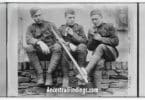When we think about Revolutionary War ancestors, we usually picture them in uniform—standing guard at a winter camp, marching along a dusty road, or writing letters home with inky quills and weary hands. We honor their service. We may even know where they fought and under which command. But what happened after they stacked their muskets and went home?
That’s a story worth telling.
Because that’s where the rest of their life began.
The Homecoming That Wasn’t Always Joyful
For some soldiers, the war ended with a return to normalcy—home to the family farm, the wife, the children, the familiar routines. But for many, there was no such smooth landing.
Homes had been destroyed or sold. Land had gone untended. Loved ones had passed away. Years lost to war couldn’t easily be reclaimed. And for some, the war had left permanent injuries—visible and invisible—that made ordinary work nearly impossible.
In fact, some veterans didn’t even make it back right away. They lingered in camps waiting for pay that never came, or traveled hundreds of miles west in search of land that had been promised but not yet parceled out.
Land Grants and the Lure of the West
For many veterans, land was the government’s version of a thank-you note. Bounty land warrants were offered to encourage enlistment and reward service. If your ancestor qualified, you might find records of a land grant application tucked away in archives or on microfilm reels digitized online.
Some of this land was in what was then considered the wilderness—places like Ohio, Kentucky, and Tennessee. Veterans moved their families out there, becoming early settlers and carving homes into dense forests and rocky hillsides. If you’ve got roots in those areas, a Revolutionary War veteran may be the reason your family ended up there.
Look for:
- Land bounty applications and warrants
- U.S. Federal land grant files
- State-issued military land claims
- Early plat maps showing lot assignments
These records don’t just show land ownership—they often include letters, affidavits, and personal statements. These little paragraphs can be pure gold for family historians, sometimes describing exactly where they lived, when they moved, and who their neighbors were.
Petitioning for Pensions
Not all veterans were lucky enough to receive land, and not all could work. Starting in 1818, Congress began offering pensions to indigent Revolutionary War soldiers. Later expansions of the law allowed for wider eligibility—including widows and dependent children.
The pension files can be lengthy—sometimes fifty pages or more—and filled with treasure. You might discover:
- Personal declarations describing military service
- Birth and marriage dates
- Details of financial hardship
- Testimonies from neighbors and fellow veterans
- Handwritten letters in the ancestor’s own words
If your ancestor lived into the 1820s, 1830s, or even 1840s, this is an excellent place to look. These pension applications often give more detail than the war records themselves.
Civilian Life: A Patchwork of New Beginnings
It’s easy to imagine veterans coming home and resuming their old trades. But in truth, many had to pivot. A weaver might become a farmer. A clerk might become a tavern owner. Some tried business ventures that failed. Others took jobs with the newly formed federal government or became local politicians. A few went into law or medicine—fields that were far less formalized than today.
Some even left the country altogether, settling in Canada or the Caribbean where opportunities—or allegiances—had changed.
Genealogically speaking, this means your ancestor may not be where you expect them to be after the war. Census records, tax rolls, and city directories can help track these shifts.
Don’t Forget the Widows
Sometimes the richest stories are told not by the soldiers, but by the women they left behind. Widow’s pension applications often contain deeply personal testimony—how they met, when they married, the names of their children, and what life was like during and after the war.
If a Revolutionary War veteran died before 1836, and his widow lived long enough to apply for benefits under the 1836 or 1838 Pension Acts, her application could include:
- A marriage certificate
- Family Bible pages
- Sworn statements from neighbors or clergy
- Descriptions of hardship, housing, and illness
These records are incredibly moving and offer details that are often missing from official government files.
Where to Look for Records
If you’re ready to look into your ancestor’s post-war years, here are some places to start:
- Fold3: Excellent source for military pensions and bounty land warrants
- National Archives (NARA): Holds federal land and pension records
- Library of Virginia or state archives: Many bounty lands and pensions were issued at the state level
- FamilySearch: Digitized land and court records
- DAR Genealogical Research System: Helpful for checking lineage from veterans who had descendants join the DAR
A Life After Service
The Revolutionary War shaped the beginnings of a nation, but it also disrupted thousands of individual lives. When the war ended, the process of healing and rebuilding began—and that’s often the part we skip when telling their stories.
Digging into those post-war years helps complete the picture. It shows us who these men became once the uniforms came off. It lets us see their struggles, their reinvention, and the lives they tried to build—not just for themselves, but for the generations that followed.
And maybe, just maybe, when you read their pension request or land deed or personal letter, you’ll hear their voice again—still speaking, long after the musket smoke cleared.






